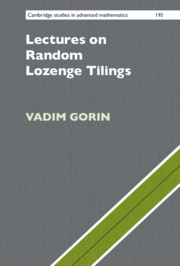Book contents
- Frontmatter
- Contents
- Preface
- 1 Lecture 1: Introduction and Tileability
- 2 Lecture 2: Counting Tilings through Determinants
- 3 Lecture 3: Extensions of the Kasteleyn Theorem
- 4 Lecture 4: Counting Tilings on a Large Torus
- 5 Lecture 5: Monotonicity and Concentration for Tilings
- 6 Lecture 6: Slope and Free Energy
- 7 Lecture 7: Maximizers in the Variational Principle
- 8 Lecture 8: Proof of the Variational Principle
- 9 Lecture 9: Euler–Lagrange and Burgers Equations
- 10 Lecture 10: Explicit Formulas for Limit Shapes
- 11 Lecture 11: Global Gaussian Fluctuations for the Heights
- 12 Lecture 12: Heuristics for the Kenyon–Okounkov Conjecture
- 13 Lecture 13: Ergodic Gibbs Translation-Invariant Measures
- 14 Lecture 14: Inverse Kasteleyn Matrix for Trapezoids
- 15 Lecture 15: Steepest Descent Method for Asymptotic Analysis
- 16 Lecture 16: Bulk Local Limits for Tilings of Hexagons
- 17 Lecture 17: Bulk Local Limits Near Straight Boundaries
- 18 Lecture 18: Edge Limits of Tilings of Hexagons
- 19 Lecture 19: The Airy Line Ensemble and Other Edge Limits
- 20 Lecture 20: GUE-Corners Process and Its Discrete Analogues
- 21 Lecture 21: Discrete Log-Gases
- 22 Lecture 22: Plane Partitions and Schur Functions
- 23 Lecture 23: Limit Shape and Fluctuations for Plane Partitions
- 24 Lecture 24: Discrete Gaussian Component in Fluctuations
- 25 Lecture 25: Sampling Random Tilings
- References
- Index
- References
References
Published online by Cambridge University Press: 31 August 2021
- Frontmatter
- Contents
- Preface
- 1 Lecture 1: Introduction and Tileability
- 2 Lecture 2: Counting Tilings through Determinants
- 3 Lecture 3: Extensions of the Kasteleyn Theorem
- 4 Lecture 4: Counting Tilings on a Large Torus
- 5 Lecture 5: Monotonicity and Concentration for Tilings
- 6 Lecture 6: Slope and Free Energy
- 7 Lecture 7: Maximizers in the Variational Principle
- 8 Lecture 8: Proof of the Variational Principle
- 9 Lecture 9: Euler–Lagrange and Burgers Equations
- 10 Lecture 10: Explicit Formulas for Limit Shapes
- 11 Lecture 11: Global Gaussian Fluctuations for the Heights
- 12 Lecture 12: Heuristics for the Kenyon–Okounkov Conjecture
- 13 Lecture 13: Ergodic Gibbs Translation-Invariant Measures
- 14 Lecture 14: Inverse Kasteleyn Matrix for Trapezoids
- 15 Lecture 15: Steepest Descent Method for Asymptotic Analysis
- 16 Lecture 16: Bulk Local Limits for Tilings of Hexagons
- 17 Lecture 17: Bulk Local Limits Near Straight Boundaries
- 18 Lecture 18: Edge Limits of Tilings of Hexagons
- 19 Lecture 19: The Airy Line Ensemble and Other Edge Limits
- 20 Lecture 20: GUE-Corners Process and Its Discrete Analogues
- 21 Lecture 21: Discrete Log-Gases
- 22 Lecture 22: Plane Partitions and Schur Functions
- 23 Lecture 23: Limit Shape and Fluctuations for Plane Partitions
- 24 Lecture 24: Discrete Gaussian Component in Fluctuations
- 25 Lecture 25: Sampling Random Tilings
- References
- Index
- References
Summary

- Type
- Chapter
- Information
- Lectures on Random Lozenge Tilings , pp. 249 - 250Publisher: Cambridge University PressPrint publication year: 2021



